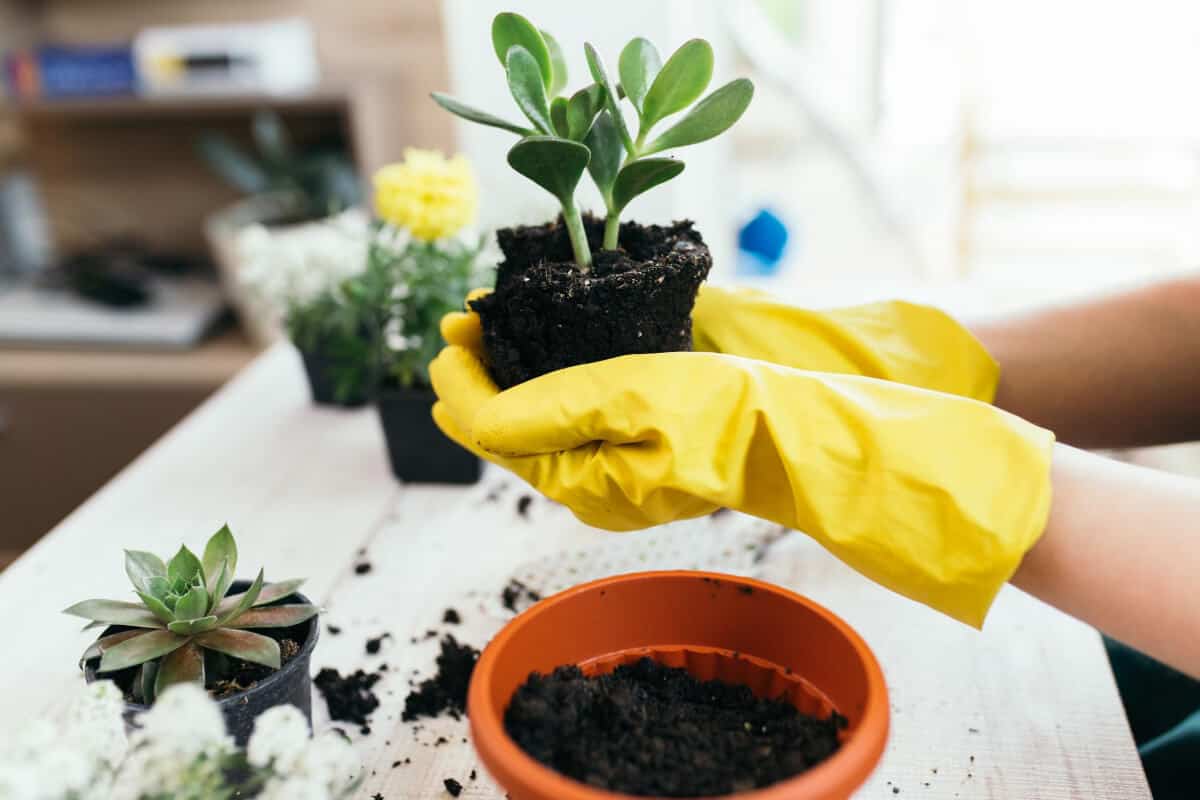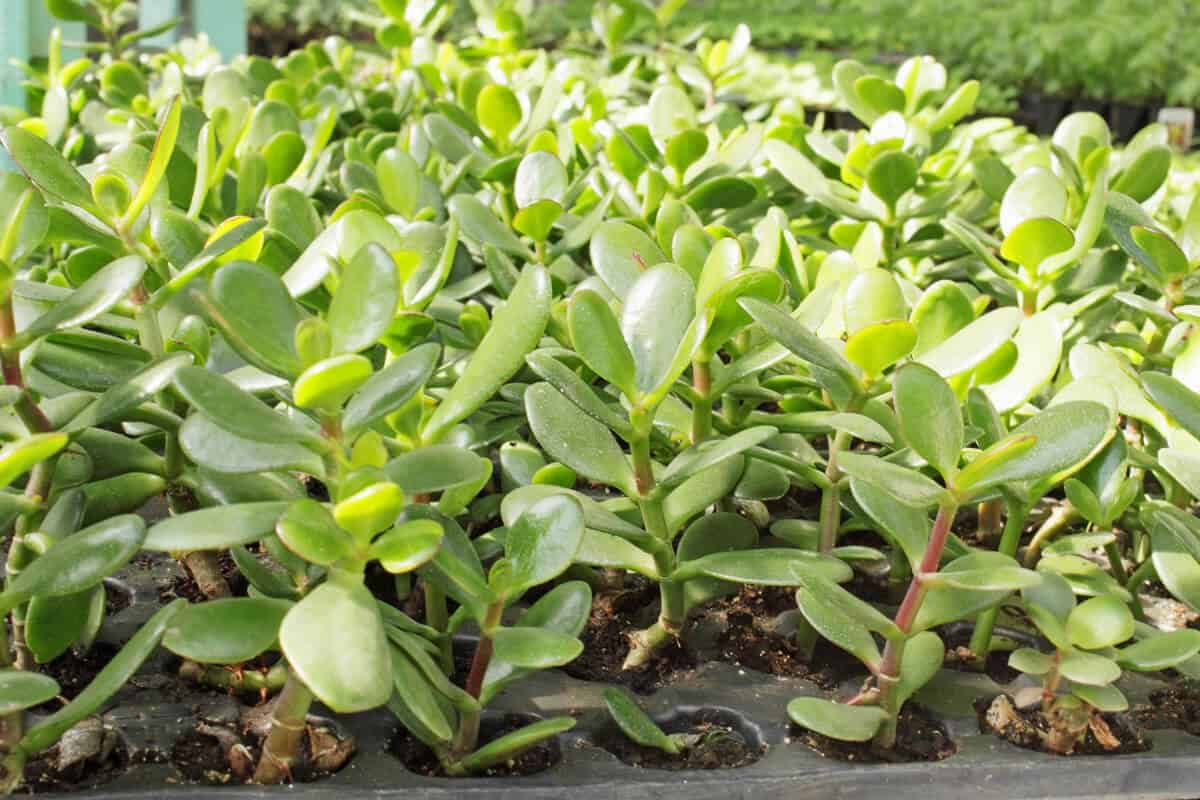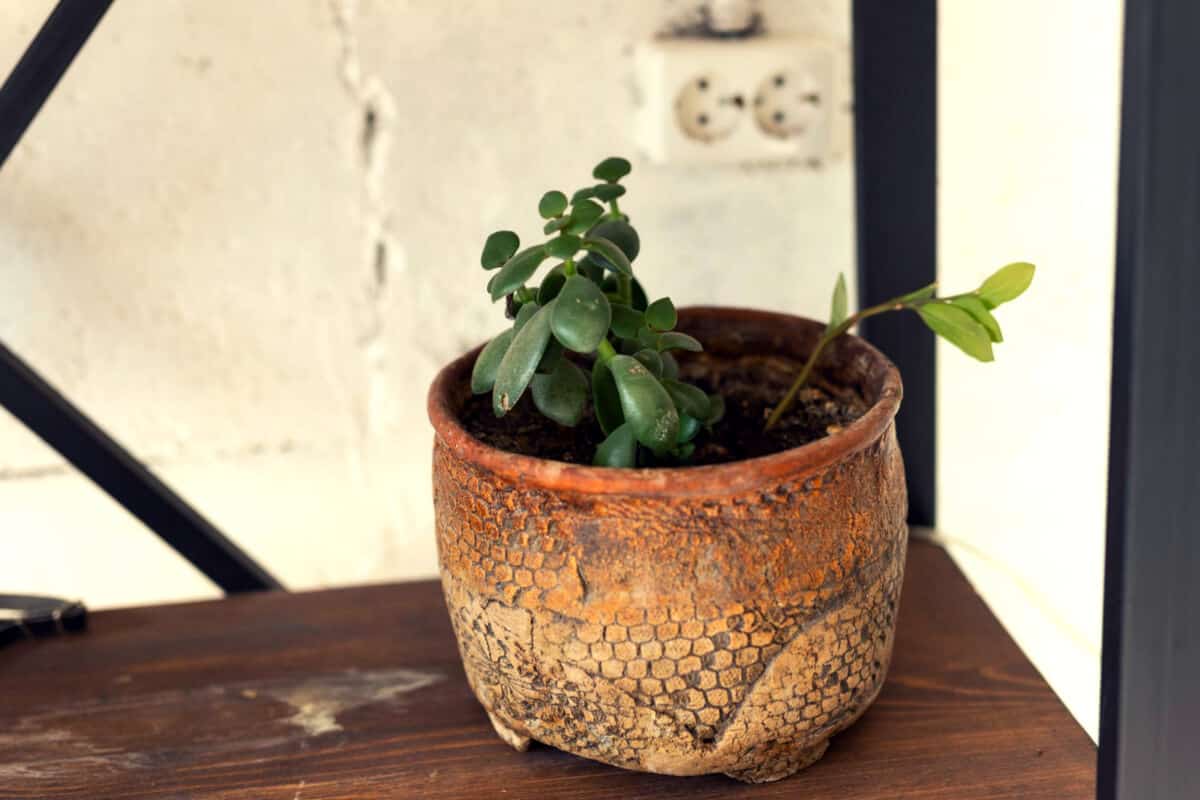The trickiest part of jade plant care is actually propagating them. Not to worry as this article will go through how to propagate a jade plant.
This involves taking cuttings from mature plants and planting them in the soil. Once they sprout roots, you can transplant them into larger pots or directly into the ground.
Propagation will require considerable patience to achieve a good-sized plant when using a leaf cutting. Stem cuttings off the Jade plant will offer a quicker alternative.
Either method is relatively easy, and each will provide you with a great way to propagate. This article will show you how to propagate the jade plant with different methods.

Jade Plant Propagation Equipment and Materials
Jade plants are also commonly known as Lucky plants or Money plants. They are easy to propagate from either stem cuttings or leaf cuttings. It is important to work with a healthy leaf of a Jade plant when propagating.
Before beginning the propagation method, prepare the following tools and materials.
- Leaves of stem cuttings from a healthy Jade plant
- Potting soil mix for succulents and cacti*
- Rooting hormone
- Clean plant containers
- Sterile gardening shears or clippers
*It is possible to blend your own growing medium using potting soil, perlite soil mixture, and some coarse sand mixture.
Learn more about Jade Plant Soil.
When to Propagate a Jade Plant
The Crassula Ovata or Jade plant loves warmth and humidity.
Summer is the perfect season for the propagation of a Jade plant. However, you can propagate this plant at any time of year.
How to Propagate the Jade Plant from Stem Cuttings
Using stem cuttings for Jade plant propagation is probably the easiest method available.
Stem cuttings can be any size, from small to quite large.
This means that any branch that breaks from a healthy plant can be used as well as clippings from pruning your jade plant.
1. Taking a Stem Cutting for Propagation
- Select a healthy branch on a Jade plant for stem cutting.
- Cut a 3-to-4-inch length of the stem using sterile gardening shears or clippers.
- Remove any bottom sets of leaves from the stem cutting. Jade plant cuttings will form roots from leaf joints. If you have several leaf joints, there is a better chance of roots forming.
2. Preparing the Jade Plant Stem Cutting for Propagation
- Leave your stem cutting in a warm dry location for 2 to 3 days.
- This will allow the point of cutting to callous over.
- Should you select a large branch, leave it to callous over for as long as necessary.
Tip: Callousing over a jade plant cutting point is especially important if propagating in winter.
3. Completing Propagation
- Once the cut end of the stem has calloused over, dip this end in the rooting hormone.
- Fill a container with succulent potting mixture.
- Form a hole in the soil for the stem cutting with your finger.
- Place the cutting into the hole.
- Pack soil lightly around the base of the stem cutting.
- Place in a warm location with bright indirect light. Do not expose it to direct light.
- Do not water your stem cutting until new roots have developed. If you live in an arid climate, you can mist your plant cutting daily very lightly. Do not exaggerate when misting as high humidity is not necessary.
- When the Jade plant cuttings show new growth on top, you’ll know that roots have formed.

How to Propagate a Jade Plant from Leaf Cuttings
Propagating Jade plants from leaf cuttings is possible. It will require more time so arm yourself with patience.
1. Taking a Leaf Cutting
- Break a single leaf off the healthy mature plant.
- Make sure to get a jade leaf with its entire stem attached.
- Broken leaves without stems will not form roots.
2. Preparing the Jade plant Leaf for Propagation
- It is not necessary to dry leaves out or callous over as with a stem cutting, but you can if you wish.
- Do not allow them to dry or callous for too long as they may shrivel up.
3. Completing Leaf Cutting Propagation
- Dust or coat the end of your leaf cutting in rooting hormone.
- Prepare the pot with succulent soil mix.
- Lay the leaf on top of the soil mixture.
- Cover with a light dusting of soil.
- Place the leaf-cutting in a bright warm spot, not in direct light from the sun.
- Do not water until roots have formed. You can mist lightly daily if the air is arid.
- Water once roots have formed and new growth is apparent.
How to Propagate a Jade Plant in Water
The water method is favored by many, as it is very easy and provides quicker results. You can also do the water method from your leaf cuttings.
1. Snip off a stem of 4 to 6 inches from a healthy, mature Jade plant.
2. Remove any bottom sets of leaves.
3. Allow the cutting to dry out in a warm, clean location until the cut end callouses over.
4. When the cut end has formed a callous, place it in a 4-inch jar or glass filled with clean filtered, fresh water, or collected rainwater.
5. If necessary, use toothpicks to keep your cutting in place. Leaves must not get wet.
6. Position the cutting in a spot with bright indirect sunlight.
7. Change the water in the jar every three to five days. Clean the jar to avoid bacteria or fungi buildup.
8. When several roots develop from the cutting base, transplant it to a pot with succulent potting soil mixture, or to a larger vase with water.
Jade plant propagation in water tips:
- Always use water that is not chlorinated.
- Keep your plant away from drafts.
How Long Does a Jade Plant Stem or Leaf Cutting Need to Form Roots?
This will depend on the environmental conditions it is being propagated in.
Dry locations with little or no humidity will require longer. In environments with average humidity, it generally requires 2 – 3 weeks for roots to form.

Transplanting and Repotting Rooted Cuttings
It is recommended to leave your new baby plants in the original pots used for cuttings until they outgrow them.
When they need to be repotted, choose clay or terra cotta pot as this will aid with excess moisture. Repot using a potting mixture formulated for succulents and cacti.
How to Propagate a Jade Plant Final Thoughts
Jade plants are easy to grow and require very little maintenance. They’re perfect for beginners who want to add a bit of greenery to their home without having to spend hours tending to each individual plant.
Once you have a thriving jade plant, you can use its leaves to create beautiful arrangements. Just be careful not to let the foliage dry out too quickly because it can cause the plant to turn brown and die.
Learn more about jade plants with these other articles:

